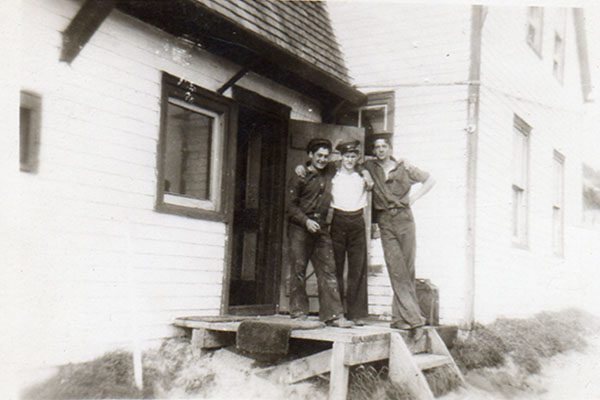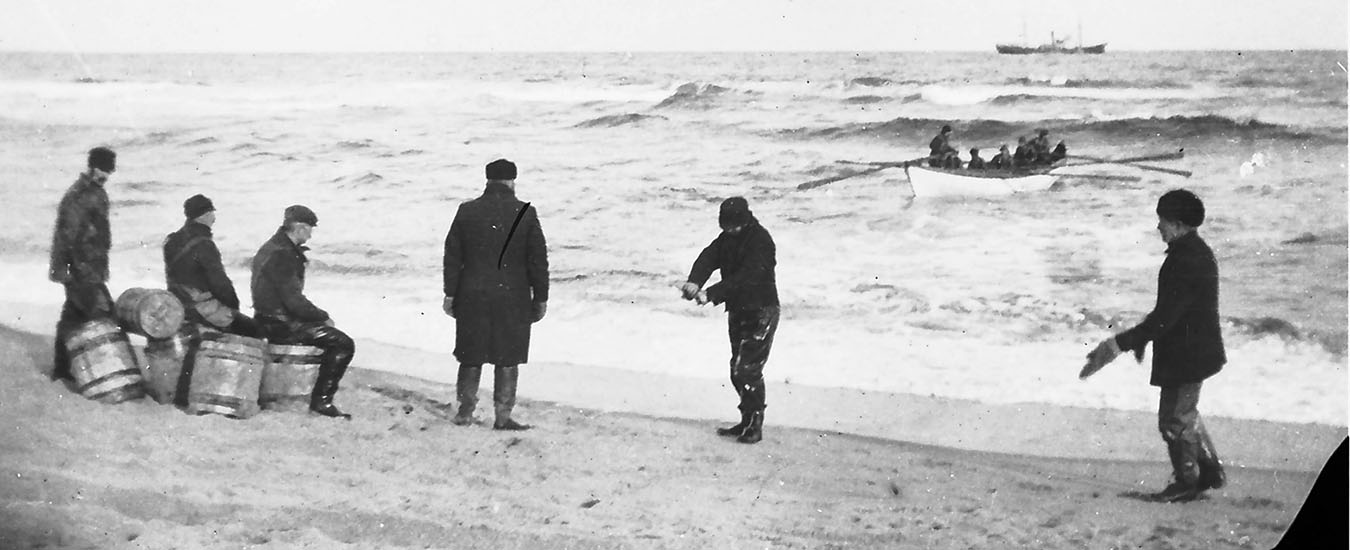The days when Sable Island was a bona fide graveyard for ships
by Anne L. Calder
Aubrey Dauphinee takes us back to a time when shipwrecks were an all too often reality on Sable Island and travel from the mainland was also treacherous.
Just after VE-Day, 1945, the 17-year-old from Queensland, NS quit his job as a steel cutter at the Halifax Shipyard and left for work on Sable Island, the 44-kilometre long crescent sandbar 304 kilometres southwest of Halifax.
Dauphinee, 92, currently resides in Bridgetown, NS and has crystal clear memories of his time spent on Sable.
Time for change
“A group of us wanted to get out of the shipyard,” says Dauphinee. “I was making $92 a week, which was fantastic, but the war was over and we didn’t want to stay. They weren’t looking for particular skills on Sable Island, they just wanted people there.”
An eager young crew set out for Sable on the HMCS Lady Laurier one sunny summer afternoon. Morning light revealed a massive fog bank, the likes of which Dauphinee had never seen. He was soon assured it was not a fog bank: it was Sable Island.
“We started soundings three miles off to see where the sandbars were and we got within a mile and a half before we hit the first one. We got past that and dropped two anchors but started to drift.”
“We eventually found refuge and unloaded supplies—vegetables, canned goods and oil—into surf boats that we rowed ashore. We were pretty tired after six trips back and forth to the ship but it was amazing that so much got accomplished in one day.”
The main station on Sable Island in 1945 consisted of the superintendent’s house, built in 1870, a meteorological balloon shed and one large out building. It was fenced in with a grass lawn.
Closer to the main lighthouse was a dorm for the crew and a smaller house for the two men who would watch the light. There was also a boat house, barn, root cellar and supply shed where oil drums were stored.
Wages were $15 a month, plus board. “You bought all your own supplies except clothing,” says Dauphinee. “The clothing was the very best of Mae West vests and naval issue heavy wool turtleneck sweaters.”
Dauphinee’s duties on Sable Island included acting as lighthouse keeper, Morse code operator and member of the life-saving team.
“We found out quickly what we had to do and were up at six each day, headed for the stables. We had eight horses that were broken (trained) and that had to be fed, watered and their bedding changed before we could return to the main house for breakfast. Superintendent Johnson was a former RCMP sergeant from Sydney and if he came to the barn and there was movement of water or unsightly dirt, he told us to clean it again. And we did.”
The crew also had to maintain the telephone line to the mainland daily, which meant having someone travel halfway across the sandbar to co-ordinate the telephone line with the eastern light.
Boats, rope and life-saving equipment needed constant upkeep. Dauphinee doesn’t believe the lifeboat they used had been put in the water for years because it leaked like a sieve.
“If you were a part of the life-saving crew you had to be able to get in and out of the boat in the water. We initially practised our drills on Lake Wallace. That meant upsetting the boat so that everyone would be in the lake. It was completely experimental. We had to wear full equipment: rubber boots, big jackets, sou’westers, the whole water supply you would need and then we’d do that again in the ocean—and it was cold.”
“I knew Morse code very well,” says Dauphinee. “It came easily. But when I left Sable, it was all gone. I have the code with me even now but I don’t want to see it. It was a real effort to send messages by an Aldis lamp, by flags, and by tapping on a key.”
Dorm life
“Eleven men stayed at the main dormitory,” says Dauphinee. “Superintendent Johnson and his wife lived at the main station.” Food supplies were delivered to the Island every four to six months.
“Eggs were always packed in salt, most of the foods were canned, we had salt beef, salt this, salt that.”
“We had a big dining room inside a massive kitchen at the dorm. We had an excellent cook, Ralph Begin. Dinners were huge. There was a solarium and our washroom where we did our bathing. We had a fireplace, eight single dorm rooms and two doubles.”
Now and then, American food rations from ships would drift up on the beach.
“We thought we got a good one one day!” Dauphinee remembers. “But when the superintendent heard about it he said to bring it to the main house so he could see it. He told me to set the can on a fence post and he took out his rifle. And poof! There were 90-lb detonators inside!”
“He was an excellent man, very strict, but he had to be. I fell asleep one night on watch and the light stopped. All I heard next was a rifle shot. He wouldn’t shoot at the house of course, but it was close. It didn’t take me long to go straight up those stairs to the light.”

All Images Courtesy of Aubrey Dauphinee
The lighthouses
“Two of us would go on at sunset and make sure the light was set just before the sun went down. One would work until one in the morning, then your partner took over until the sun rose in the east.”
“The rest of our day was ‘clean the glass, clean the brass, clean the jewel nuts’. There’s 7,000 lbs. of brass and glass to be cleaned so you climb inside the telescope with wood alcohol and clean it all. That would repeat itself an hour before sunset. You only worked half a day, but you were allowed to sleep the extra half day.
“One day I was called to replace an injured worker at the East Light. I had never ridden a horse and there were 28 miles of dunes for me to cross. My horse, Tony, would come up and I would go down. Halfway there I dropped my trousers and found blood running down both legs (from chafing, having never ridden a horse previously).
“I met the chap coming the other way in a buckboard with the wounded man. In the end, I took the buggy to the East Light and they took Tony. When I called the superintendent he said, ‘Well, go jump in the ocean, the salt water will heal you up. Then you’re on from midnight ’til morning.’”
“The east bar was fogged in. We’d ride a horse east on the north side to the tip, then back to the south. At one point my horse was going awful slow so I dug in my heels and said ‘git-up’. He did. He took me up into the barn and didn’t say ‘duck’. I hit my head on the cross bar—he went in and I went down. That horse was a whole lot smarter than me.”
The elements
The worst weather Dauphinee encountered was a hurricane in December, 1945.
“It was miles an hour, not kilometres then. She was blowing 108. I come out of the boat house to go to the barn and I flew up above the boat house and slammed onto the deck of the barn. When I stood up the next gust took me again. If it wasn’t for a sand dune between the barn and the north sea, nothing would have stopped me.”
“The seas were running 80 feet high and there was a Boston fishing trawler stuck on the east bar. We put the life boat in at Main Station but we were only six in a 14-man lifeboat.”
“A corvette came out to help but it would go up on one wave and down on the other and her bow cracked the centre of our boat. It’s lucky we saw it and ducked because our heads would have been in there.
“We never got to the Gale—she was finished. But the men got off by jumping into fishing dories. Two had broken ribs but other than that they were okay.
“We were eventually taken by corvette to Sydney. We were given two dollars each and thought, ‘Excellent! We can have a nice meal.’ But the money was to get our hair cut. And that’s what we did.”
The most infamous shipwreck while Dauphinee was on Sable involved the Greek freighter Alfios. It struck the sandbar going full steam. An attempt by the rescue crew to help was met with rejection by her captain, asking that the “gentlemen” go away and instead send tug boats. He stood firm.
Five days later, with the assistance of a mine sweep vessel, the crew finally disembarked and were held outside until government officials processed them. The Alfios was destroyed.
“The only ship that ever hit the sand and got off on the next wave was the Bluenose,” says Dauphinee. “It was under Angus L. MacDonald. He was briefly stuck but the second wave took him off the bar.”
